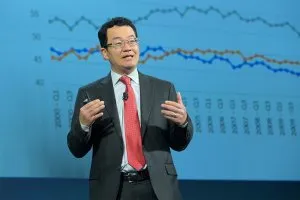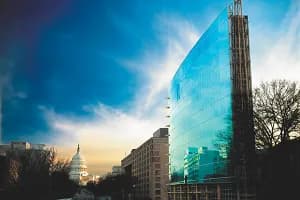At President Obama’s request, Congress has appropriated more than $10 billion for the construction of new intercity rail lines. Economic studies suggest that these new trains could increase real estate values. California is the most likely state to receive federal funds, to help complete a high-speed rail corridor linking Sacramento to San Diego. Florida may receive funds for a route linking Tam.pa and Orlando. Texas, Virginia, Wisconsin, North Carolina, and Ohio are other possible grantees.
Early in 2009 Congress passed a stimulus package at President Obama’s request that included $9.3 billion for the construction of new passenger train lines. The president followed that up with an additional budget request of $1 billion a year for the next five years. The 2009 Omnibus Appropriations Act includes $90 million in matching grants for intercity passenger rail travel.
The federal support could help the United States reduce its automobile dependence. Unlike other modern industrial countries like Japan or those in Europe, the country lacks a true high speed rail train. The $787 billion stimulus package included $1.3 billion for Amtrak and $8 billion for passenger train capital grants, including money to develop high speed rail in 11 corridors across the country.
Clear Benefits
In remarks to the National League of Cities this past spring, U.S. Transportation Secretary Ray LaHood stressed that the goal behind all the transportation money included in the stimulus bill was not only to create jobs but to help make communities more sustainable. “This effort not only puts people to work, it gets people to work in a way that moves us toward our long-term goals of energy security and more livable com.munities,” said LaHood.
Indeed, economic studies done for a high speed rail project to link Sacramento to San Diego, by way of San Francisco and Los Angeles, suggest that the train would increase land value by facilitating denser development. A study of economic benefits in Los Angeles concludes that demand to be near these new intercity rail stations will lead to more commercial/residential infill developments, pushing up property values. Another study points out that the cities of Ontario and Riverside in Southern California are already looking to create transit-oriented business and housing developments in order to put customers, jobs, and retail outlets in close proximity to one another.
Advocates for passenger rail service stress that the stimulus package money won’t suddenly create a network of bullet trains across the country. Instead, the money can be used by any train that achieves speeds of 110 mph, which is considerably less than ones already operating abroad.
“It’s unprecedented but it will not do what people say it will do, which is run bullet trains,” said Ross Capon, president of the National Association of Railroad Passengers.
The Federal Railroad Administration states that the idea is to provide service that is “time competitive” with both air and auto travel within 100 to 500 miles. But the FRA also states that it wants to hand out money to “ready-to-go” projects for which planning, environmental impact studies, and preliminary engineering activities have been completed.
California in the Lead
The state already the farthest along is California. Voters in that state approved a $9-billion bond referendum in November 2008 to help pay for an 800-mile high speed rail system that would traverse the state from Sacramento to San Diego. The referendum also included an additional $950 million to pay for urban, intercity, and commuter rail lines to link up with the high-speed trains. The state is already moving ahead with the first phase of the project, expected to link the Los Angeles-Anaheim area to San Francisco. Travel between San Francisco and downtown Los Angeles would take roughly two and a half hours once the train starts running.
Judge Quentin Kopp, chairman of the California High Speed Rail Authority, said he is “confident” that his state can get a large share of the federal money because it is pressing ahead with a train capable of 200 mph. “I think it’s wonderful and I’m reasonably confident of getting a substantial amount of allocated grants from that,” Kopp said. “California is unique.”
Kopp said that the state could finish sections of this first 520.mile phase by 2013, with an estimated completion date of 2018-2020. The entire $45-billion system is expected to be finished by 2025.
Capon agrees that these aggressive efforts place California far ahead of other states.
“Clearly they have done more for laying the foundation for true high speed rail,” he said. “It could provide a significant boost to the California high speed project. The fact is that most of the other states are working on what we call incremental upgrades in conventional services.”
Florida Another Likely Prospect
In 2004, then-Gov. Jeb Bush, concerned about the potential cost, led a charge to repeal a constitutional amendment which had mandated that Florida create a high speed rail system to tie its major cities together. Before the state’s bullet train was axed by voters, the state had spent $30 million and pursued critical environmental studies for a route connecting Tampa to Orlando.
The Florida High Speed Rail Authority now anticipates that it could begin construction within the next two years, and the Florida Department of Transportation says it has federal grants in hand that could be used to finish the work needed to draw down stimulus money.
Other States Not Far Behind
California and Florida will not be alone in trying to land billions in federal assistance for passenger train travel.
- Texas wants to expand the rail corridor connecting Fort Worth, Houston, and San Antonio.
- Virginia and North Carolina have already done a lot of the groundwork on a route to link Charlotte and Raleigh, N.C., to Washington, D.C.
- Wisconsin wants to move ahead with trains that would link Milwaukee and Madison, and to improve the existing route from Chicago to Milwaukee.
- Ohio wants federal money to restart passenger rail service along the so-called “3C” corridor that would link the cities of Cleveland, Columbus, and Cincinnati. Private passenger rail travel along this corridor ended in 1971. Jolene Molitoris, director of the Ohio Department of Transportation, testified before Congress that with federal stimulus help, Ohio could be in “operation quickly” on existing tracks at conventional speeds, laying a foundation for high speed rail in the future.








